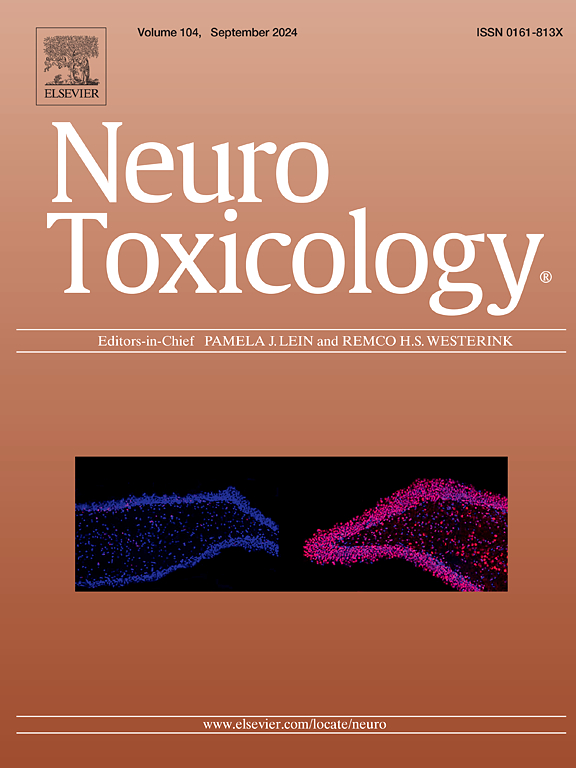Kisspeptin-10 protects against HIV-1 Tat-induced blood-brain barrier dysfunction and neuroinflammation via RhoA/ROCK pathway: Implications for HAND therapy
IF 3.9
3区 医学
Q2 NEUROSCIENCES
引用次数: 0
Abstract
This study investigated the effects of Kisspeptin-10 (Kp-10) on HIV-1 Tat-induced blood-brain barrier (BBB) permeability and oxidative stress using both in vivo and in vitro models. In vivo, one hour after intraperitoneal administration of 50 nmol/kg (DSS)*6-Kp-10, mice were intravenously injected with HIV-1 Tat (100 μg/kg). Markers of oxidative stress, inflammatory cytokines, and BBB integrity were then evaluated. In vitro, bEnd.3 cells were treated with HIV-1 Tat and Kp-10, and endothelial permeability, Claudin-5 expression, and RhoA/ROCK signaling were assessed. HIV-1 Tat increased oxidative stress in the cortical tissue of mice, as evidenced by elevated malondialdehyde (MDA) and reduced levels of catalase (CAT) activity, glutathione peroxidase (GSH-Px) activity, and total antioxidant capacity (T-AOC). These effects were attenuated by Kp-10 administration. Additionally, Kp-10 suppressed the expression of pro-inflammatory cytokines, including interleukin-6 (IL-6), monocyte chemoattractant protein-1 (MCP-1), and tumor necrosis factor-alpha (TNF-α), in response to HIV-1 Tat. Notably, Kp-10 mitigated HIV-1 Tat-induced BBB dysfunction by upregulating Claudin-5 expression in the cortical tissue of mice. In vitro, bEnd.3 cells were treated with HIV-1 Tat in the presence of Kp-10 at various concentrations. Our results demonstrated that Kp-10 prevented HIV-1 Tat-induced increases in trans-endothelial permeability and reductions in transepithelial electrical resistance (TEER) by upregulating Claudin-5 expression. Furthermore, Kp-10 inhibited the activation of the RhoA/Rho-associated protein kinase (RhoA/ROCK) signaling pathway in bEnd.3 cells. Overexpression of the RhoA-GTP Q63L mutant abolished the protective effects of Kp-10, suggesting that these effects are mediated through the RhoA/ROCK axis. These findings suggest that Kp-10 might be a potential therapeutic agent for HIV-associated neurocognitive disorders (HAND).
Kisspeptin-10通过RhoA/ROCK途径预防HIV-1诱导的血脑屏障功能障碍和神经炎症:手部治疗的意义
本研究通过体内和体外模型研究了Kisspeptin-10 (Kp-10)对HIV-1 tat诱导的血脑屏障(BBB)通透性和氧化应激的影响。在体内,腹腔注射50 nmol/kg (DSS)*6-Kp-10 1小时后,小鼠静脉注射HIV-1 Tat (100μg/kg)。然后评估氧化应激、炎症细胞因子和血脑屏障完整性的标志物。在体外,bEnd。用HIV-1 Tat和Kp-10处理3个细胞,评估内皮通透性、Claudin-5表达和RhoA/ROCK信号传导。HIV-1 Tat增加了小鼠皮质组织的氧化应激,其证据是丙二醛(MDA)升高,过氧化氢酶(CAT)活性、谷胱甘肽过氧化物酶(GSH-Px)活性和总抗氧化能力(T-AOC)水平降低。给药后这些作用减弱。此外,Kp-10抑制促炎细胞因子的表达,包括白细胞介素-6 (IL-6)、单核细胞趋化蛋白-1 (MCP-1)和肿瘤坏死因子-α (TNF-α),以响应HIV-1 Tat。值得注意的是,Kp-10通过上调小鼠皮质组织中cludin -5的表达,减轻了HIV-1 tat诱导的血脑屏障功能障碍。在体外,bEnd。在不同浓度Kp-10存在的情况下,用HIV-1 Tat处理3个细胞。我们的研究结果表明,Kp-10通过上调cladin -5的表达,阻止了HIV-1 tat诱导的跨内皮通透性增加和跨上皮电阻(TEER)降低。此外,Kp-10抑制了bEnd中RhoA/ RhoA相关蛋白激酶(RhoA/ROCK)信号通路的激活。3细胞。RhoA- gtp Q63L突变体的过表达消除了Kp-10的保护作用,表明这些作用是通过RhoA/ROCK轴介导的。这些发现表明Kp-10可能是hiv相关神经认知障碍(HAND)的潜在治疗剂。
本文章由计算机程序翻译,如有差异,请以英文原文为准。
求助全文
约1分钟内获得全文
求助全文
来源期刊

Neurotoxicology
医学-毒理学
CiteScore
6.80
自引率
5.90%
发文量
161
审稿时长
70 days
期刊介绍:
NeuroToxicology specializes in publishing the best peer-reviewed original research papers dealing with the effects of toxic substances on the nervous system of humans and experimental animals of all ages. The Journal emphasizes papers dealing with the neurotoxic effects of environmentally significant chemical hazards, manufactured drugs and naturally occurring compounds.
 求助内容:
求助内容: 应助结果提醒方式:
应助结果提醒方式:


